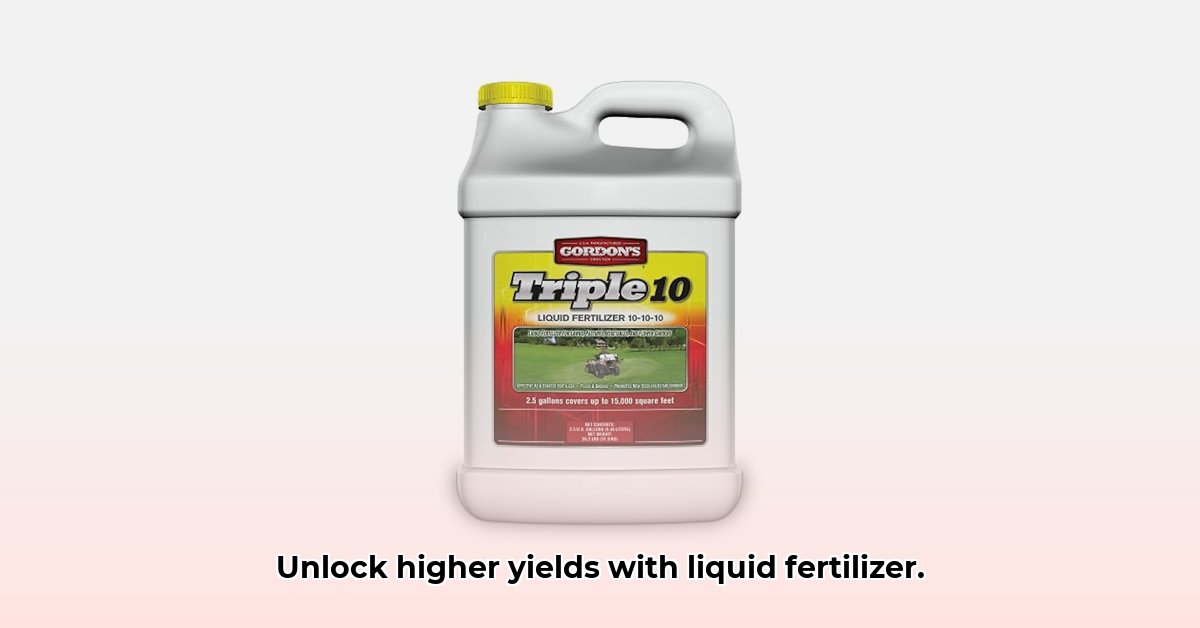
Want bigger, healthier crops without harming the environment? This guide shows you how to effectively and sustainably use liquid fertilizers from Tractor Supply. We'll cover selecting the right fertilizer, applying it correctly, ensuring safety, and troubleshooting potential problems. Let's get started! For more information on Tractor Supply fertilizers, check out this helpful resource.
Choosing the Right Liquid Fertilizer: Matching Needs to Products
Tractor Supply offers various liquid fertilizers, each formulated for specific plant needs and soil conditions. Selecting the right one is crucial for maximizing yield and minimizing waste. A soil test is your first step. It reveals nutrient deficiencies, guiding your fertilizer choice. (A soil test is an analysis of your soil's composition, identifying nutrient levels and pH). Then, consider your crop's needs. Leafy greens often benefit from nitrogen-rich fertilizers, while fruiting plants require more phosphorus and potassium. The NPK ratio (Nitrogen, Phosphorus, Potassium) on the product label indicates the nutrient balance. Match this ratio to your soil test results and crop requirements.
Application Methods: Optimizing Efficiency and Sustainability
Several methods exist for applying liquid fertilizers, each with its own advantages and environmental impacts.
Broadcast Application: This involves evenly spreading the fertilizer across the field. While simple, it's less efficient, leading to potential nutrient runoff and waste (Studies show broadcast application can lead to up to 30% nutrient loss).
Band Application: This places fertilizer in narrow strips near plant roots, improving efficiency and reducing runoff. This localized application method is generally more environmentally friendly and cost-effective.
Fertigation: This involves injecting fertilizer directly into your irrigation system for precise application. This targeted approach minimizes waste and maximizes nutrient uptake, representing a best practice in sustainable agriculture.
Choosing the ideal method depends on your farm size, crop type, equipment, and sustainability goals. For optimal environmental impact and economic efficiency, band application or fertigation are preferred.
Calculating Fertilizer Rates: Precision for Maximum Yield
Applying the correct amount of fertilizer is vital. Too much wastes resources and harms the environment; too little hinders crop growth. Follow these steps:
Interpret Soil Test Results: Your soil test provides a baseline of existing nutrients.
Check Fertilizer Label: This shows the concentration (e.g., pounds of NPK per gallon). Pay close attention to the units of measurement to avoid errors.
Use a Fertilizer Calculator: Many online resources provide fertilizer calculators that help determine the optimal application rate based on your soil test, crop needs, and fertilizer concentration. These tools take the guesswork out of the equation, ensuring precise application. (A fertilizer calculator is a tool that uses soil test data and crop requirements to determine the appropriate fertilizer application rate).
Remember, precision is key to maximizing yield and minimizing waste. Using a calculator ensures accurate application rates.
Safety Precautions: Protecting Yourself and the Environment
Liquid fertilizers are powerful chemicals that require careful handling. Prioritize safety by:
Wearing Protective Gear: Always wear gloves, eye protection, and long sleeves when handling liquid fertilizers. Avoid skin contact and inhalation of fumes.
Proper Storage: Store fertilizers in a cool, dry, well-ventilated area, away from children and pets. Keep containers tightly sealed.
Mixing Cautions: Never mix different fertilizers unless the label explicitly states it’s safe; incompatible mixtures can generate dangerous reactions.
Spill Response: Clean up any spills promptly using absorbent materials, preventing soil and water contamination.
Following these guidelines protects you and the environment from potential harm.
Troubleshooting Common Problems: Addressing Fertilizer Issues
Even with careful planning, issues can occur.
| Problem | Possible Cause | Solution |
|---|---|---|
| Fertilizer Burn | Excessive fertilizer; improper application | Flush the affected area with water; adjust application rate and method. |
| Nutrient Deficiencies | Inadequate fertilization; soil imbalance | Conduct another soil test; apply the appropriate corrective fertilizer. |
| Uneven Growth | Uneven fertilizer application; soil conditions | Adjust application method; improve soil health (e.g., composting). |
Sustainability Considerations: Environmentally Conscious Practices
Sustainable agriculture prioritizes long-term soil health and environmental protection.
Minimize Runoff: Employ methods like banding or fertigation to reduce nutrient runoff (Proper fertilizer management reduces nutrient runoff by up to 75%).
Optimize Nutrient Use: Conduct regular soil tests to avoid excessive fertilization. This practice decreases waste and protects water quality.
Choose Environmentally Friendly Products: Select fertilizers formulated with reduced environmental impact.
Responsible fertilizer management contributes to cleaner water, healthier soil, and a more sustainable agricultural system.
"Precision fertilizer application is not just about maximizing yield; it’s about optimizing resource use and minimizing environmental impact. By using data-driven decisions and employing sustainable practices, farmers can achieve both high productivity and environmental stewardship." – Dr. Emily Carter, Soil Scientist, University of California, Davis.
By following this guide, you can effectively and sustainably use liquid fertilizers from Tractor Supply to achieve optimal crop yields while protecting the environment. Remember, a successful harvest is a balance of maximizing productivity and minimizing environmental impact.